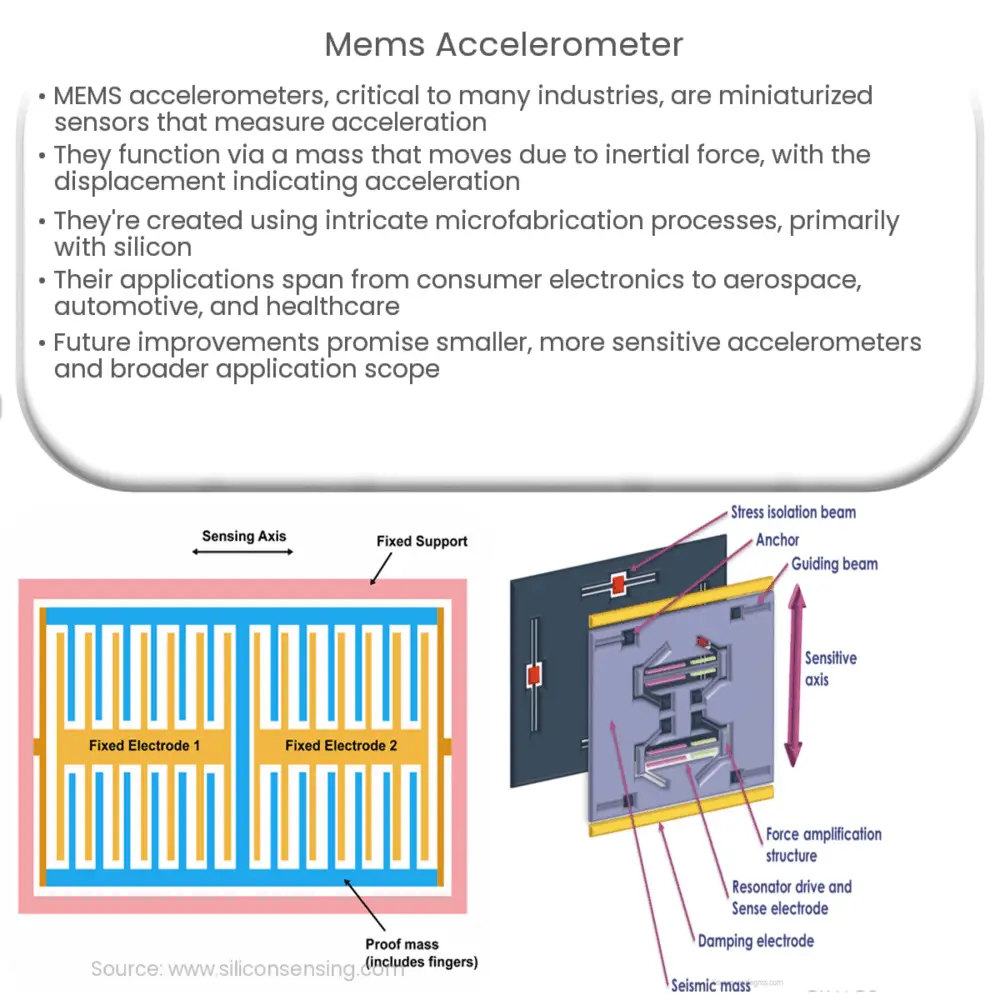A MEMS accelerometer is a miniaturized sensor measuring acceleration in 1-3 axes, used in various industries for precise motion detection.

MEMS Accelerometer: The Backbone of Modern Sensing Technology
In recent years, Micro-Electro-Mechanical Systems (MEMS) accelerometers have emerged as an indispensable component in various industries, ranging from consumer electronics to aerospace and automotive applications. These tiny, yet powerful devices have revolutionized the way we interact with our surroundings, enabling an unprecedented level of precision and control. In this article, we will delve into the fundamentals of MEMS accelerometers, exploring their working principle, fabrication process, and the numerous applications they support.
What is a MEMS Accelerometer?
A MEMS accelerometer is a highly sensitive device that measures acceleration or the rate of change of velocity with respect to time. It is a type of MEMS sensor, which are miniaturized mechanical and electro-mechanical elements fabricated through microfabrication techniques. MEMS accelerometers consist of a tiny mechanical system embedded within a semiconductor chip, capable of detecting and measuring acceleration in one, two, or three orthogonal axes (x, y, and z).
Working Principle of MEMS Accelerometers
The core of a MEMS accelerometer consists of a suspended mass, also known as a proof mass, connected to a fixed frame through a set of flexible springs. When the device experiences acceleration, the inertial force causes the mass to deflect from its equilibrium position. This displacement is proportional to the acceleration experienced and can be detected through various methods, such as capacitive, piezoresistive, or piezoelectric sensing.
In capacitive sensing, the displacement of the proof mass alters the capacitance between fixed and movable electrodes. This change in capacitance is then converted into an electrical signal, which can be processed and analyzed to determine the acceleration. Piezoresistive sensing, on the other hand, employs a change in the electrical resistance of a material due to mechanical stress, while piezoelectric sensing relies on the voltage generated by the applied stress on certain materials. Each sensing method has its own set of advantages and limitations, influencing the choice of accelerometer for specific applications.
Fabrication of MEMS Accelerometers
The fabrication of MEMS accelerometers involves a series of intricate processes, leveraging advanced microfabrication techniques such as photolithography, etching, and deposition. Silicon is the most commonly used material for MEMS accelerometers due to its excellent mechanical and electrical properties. The process begins with the creation of a silicon wafer, followed by the sequential patterning and etching of layers to form the accelerometer’s structure. The final assembly typically involves packaging the MEMS accelerometer die with the necessary electronics to create a functional device.
Applications of MEMS Accelerometers
MEMS accelerometers have found widespread use in various industries, thanks to their compact size, low power consumption, and high sensitivity. Some of the key applications include:
- Consumer electronics: Smartphones, tablets, and wearable devices use MEMS accelerometers to detect device orientation, enable gesture recognition, and support various features like image stabilization in cameras.
- Automotive industry: MEMS accelerometers are essential components in vehicle stability control systems, airbag deployment, and anti-lock braking systems. They also play a vital role in the development of advanced driver-assistance systems (ADAS) and autonomous vehicles.
- Aerospace and defense: These sensors are used in navigation systems, flight control, and vibration monitoring in aircraft and spacecraft. They also find applications in military equipment, such as guided missiles and drones.
- Industrial and structural monitoring: MEMS accelerometers are used to monitor the health and integrity of structures like bridges, buildings, and dams by detecting vibrations and potential structural failures.
- Medical devices: They are incorporated in various medical equipment, including patient monitoring systems, rehabilitation devices, and surgical tools, enabling more precise movement and control.
- Sports and fitness: Athletes and fitness enthusiasts use devices with MEMS accelerometers to track their performance, measure physical activity levels, and analyze movement patterns for injury prevention and performance optimization.
Future of MEMS Accelerometers
As the demand for more sophisticated and efficient sensing solutions continues to grow, MEMS accelerometers are expected to evolve in terms of performance, size, and power consumption. The development of new materials and fabrication techniques will likely lead to even smaller and more sensitive accelerometers, opening up possibilities for novel applications and further integration into everyday devices.
Moreover, the advent of the Internet of Things (IoT) and the increasing need for real-time data collection and analysis in various industries will drive the adoption of MEMS accelerometers in a wide range of applications. Their ability to operate in harsh environments and withstand high levels of shock and vibration makes them ideal for use in emerging technologies, such as robotics, drones, and autonomous systems.
In conclusion, MEMS accelerometers have become a cornerstone of modern sensing technology, providing vital data and enabling advanced functionality across various industries. As these devices continue to evolve and improve, their impact on our lives will only become more pronounced, shaping the future of technology and innovation.

